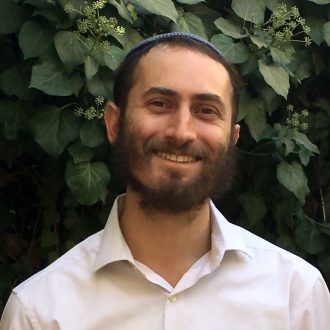Teaching #4: Sustainability in the Land of Israel

By Rabbi Yonatan Neril
Download a Printer-Friendly Version of this article
Abraham and Sarah came to Israel over 3700 years ago.[2] Since then, significant populations of Jews have spent over 1600 years living in the Land of Israel.[3] For much of this time, Jews have been involved in growing crops, tending fruit trees, and shepherding animals, activities critical to providing food to sustain those living in Israel. Yet they also presented challenges to environmental sustainability in the Land.
How did Jews manage to live in the Land for so long? While the Torah teaches that Divine Providence (in response to the people following the commandments) played the fundamental role, the Oral Tradition as redacted in the Mishna[4] also provides insights.[5]
The time period of the Mishna, before and after the destruction of the Second Temple (20 CE to 200 CE), was a period of increased demand on the natural resources of the Land of Israel. During this time, historians estimate that the Jewish and gentile population expanded to about 2.1 million inhabitants,[6] fed in good part from grain, wine, and oil produced in Israel.[7]
One important feature of this ancient economy was the shepherding of small cattle (goats and sheep). The Torah often describes the Land of Israel as “a land flowing with milk and honey,”[8] interpreted by the Talmud to mean “milk flows from the goats’ [udders], and honey flows from the dates and the figs” (Tractate Ketubot 111b). Consumption of goat milk was important in Biblical and Mishnaic Israel. Historians note that some herders raised flocks of sheep and goats in great numbers.[9]
Yet goats and sheep are voracious herbivores. The rabbis in the times of the Mishna witnessed the impact these animals had, entering farmers’ fields and eating agricultural crops. In response to the threat to crops posed by goats and sheep in the Land of Israel, the rabbis prohibited raising goats and sheep in agriculturally-productive parts of Israel (Mishna Bava Kama 7:7).[10] Clearly, the problem was widespread and understood as causing significant damage, leading the sages to place severe limitations to protect crops and the land. According to Rashi (France, 1040-1105 C.E.),[11] this was done to ensure the fulfillment of the mitzvah of settling the Land of Israel (yishuv Eretz Yisrael).
This decree presents an ancient Jewish approach to environmental sustainability—living in a way that does not unduly deplete the natural resource base on which we depend. Informed by an understanding of the impacts of sheep and goats, the rabbis of the Mishna legislated a responsible path which would sustain the Land for the long-term, even when their choices seemed contrary to short-term motivations like benefiting from goat’s milk and sheep’s wool.
In Israel today, it is not goats but water scarcity that presents a sustainability challenge. The current population is likely about five times larger than it was at its peak before the Temple was destroyed. The state of Israel struggles with ensuring water access to ten million inhabitants west of the Jordan River. Per capita water consumption has also multiplied, due to the ease and cheapness of piped-water.[12]
The ancient wisdom of our tradition can provide some clues to help us find ways to sustain ourselves on the Land. The rabbinic decree concerning sheep and goats addressed a sustainability problem by restricting one aspect of resource use in order to ensure long-term needs. Several ongoing projects seem to build upon this ancient wisdom and apply it to today. For example, one innovative, experimental project underway in Jerusalem seeks to purify and recycle waste-water from mikvehs (ritual baths) for use in irrigation. The project may be expanded to recycle water from sinks and washing machines. Such reuse of water may be one way to encourage more wise use of this precious resource, in Israel and beyond.[13]
As individuals today, we would do well to consider today whether there are areas of our consumption where we could prioritize long-term needs, especially in our choices for using energy, water, food, and consumer products, each major contributors to today’s sustainability challenges.
The Rabbis’ understanding of this decree as linked to yishuv Eretz Yisrael (settlement of the Land of Israel) is striking. It underscores that settling the Land of Israel is not only about the commandment incumbent upon individual Jews, but the greater communal responsibility for settling sustainably. And it is not just about settlement of the Land now, but also sustaining it for future generations. We must live on the earth in a way that lasts for generations by maintaining its natural resource base.
These laws, in providing us clues as to how the Jewish people lived on the Land for so long, underscore the importance of national thinking and planning for sustainability, and elucidate Jewish values which may help us address current and future challenges. May we embrace sustainable living as an act of profound religious significance, and merit to live long on the land.

Rabbi Yonatan Neril founded and directs Jewish Eco Seminars, which engages and educates the Jewish community with Jewish environmental wisdom. He has worked with Canfei Nesharim for the past six years in developing educational resources relating to Judaism and the environment.
Notes
1. The author thanks Evonne Marzouk for her insights and editorial comments in developing this article.
2. In the year 2023 in the Jewish calendar or 1737 B.C.E
3. Joshua led the Jewish people into Israel in 2490 (Jewish calendar) or 1270 B.C.E, where they remained (aside from the 70-year Babylonian exile) in significant numbers for about 1600 years (until about 400 C.E., when the Jewish population continued a centuries-long decline).
4. The Mishna was codified by Rabbi Yehuda Hanasi about 200 C.E.
5. According to the Ramban (Nachmanides, Spain, 1194-1270), the Torah commands that Jews settle the Land of Israel. He counts settling the Land of Israel among the 613 commandments (Ramban to Sefer Hamitzvot, positive mitzva #4, and Ramban to Bamidbar 33:53.). The Midrash states that this includes planting trees and crops in the Land (Midrash Bereshit Raba, chapter 64).
6. About 30% of this total were non-Jews. This estimate was given by Dr. Meir Bar Ilan, senior lecturer, departments of Talmud and Jewish History, Bar Ilan University, Israel, personal communication, March 2010. This estimate is based on the past several decades of research, following Byatt, Anthony (1973) “Josephus and Population Numbers in First-century Palestine”, in: Palestine Exploration Quarterly, 105, pp. 51–60. That article provides a spectrum of about twenty scholarly opinions ranging from between below one million inhabitants and above six million inhabitants.
7. “The Period of the Second Temple,” by Prof. Menahem Stern, in A History of the Jewish People, ed. Ben-Sasson, Harvard Univ. Press, Cambridge, MA, 1976, p. 268-70. Prof. Stern notes that during the end of the Second Temple era, “the economy of Palestine continued to be based on agriculture, as it had been throughout antiquity…The three main crops, as in earlier times, were grain, wine, and olives. In normal years the country supplied sufficient grain to meet its own needs and even to export some…Next to agriculture in economic importance among the Jews of Palestine were animal husbandry [i.e. raising cattle, sheep, and goats] and fishing.” Prof. Gedalyahu Alon concurs that the three main aspects of the economy were agriculture, fruit orchards, and animal husbandry and that Israel was usually self-sufficient and even a net-exporter of grain. He proves this from several Rabbinic and historical texts (Toldot Hayehudim B’Eretz Yisrael B’Tkufat Hamishna v’ha’Talmud, p. 99). See also Bava Metzia 107a on Rabbi Yochanan teaching to divide one’s holdings between grain, olive trees, and grapevines.
8. Dr. Akiva Wolff notes that the Torah uses this expression sixteen times, including in Deuteronomy 31:20. It appears an additional fifteen times elsewhere in Tanakh. Dr. Wolff explores the environmental linkages of the following decree on goats and sheep in his article on the Torah portion of Vayeilech in Canfei Nesharim’s Eitz Chaim Hee series, available at www.canfeinesharim.org.
9. Toldot Hayehudim B’Eretz Yisrael B’Tkufat Hamishna v’ha’Talmud, p. 101-2
10. See also Rambam Hilchot Nizkei Mammon 5:2. Forests and desert areas were exempt from this decree.
11. To Bava Kama 79b. The Talmud there and on p. 80a discusses qualifications to this decree, and also mentions spiritual dangers to going against this decree.
12. For more on the topic of water use in the land of Israel, see the Jewcology water article written by this author.
13. Haaretz, June 2, 2009, “Experimental program to recycle waste-water tries to get God, Mother Earth on the same page” by Zafrir Rinat. The article describes a project of the Jewish environmental organization Shomera.
